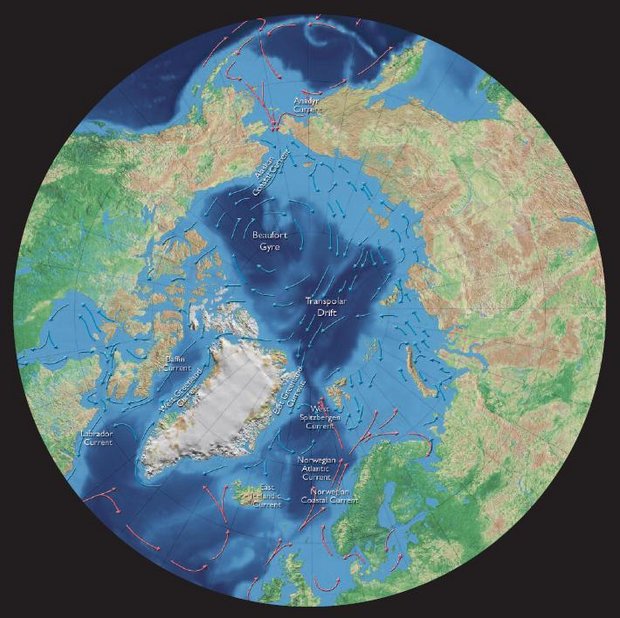General features of Arctic marine systems
This is Section 9.2.1 of the Arctic Climate Impact Assessment
Lead Author: Harald Loeng; Contributing Authors: Keith Brander, Eddy Carmack, Stanislav Denisenko, Ken Drinkwater, Bogi Hansen, Kit Kovacs, Pat Livingston, Fiona McLaughlin, Egil Sakshaug; Consulting Authors: Richard Bellerby, Howard Browman,Tore Furevik, Jacqueline M. Grebmeier, Eystein Jansen, Steingrimur Jónsson, Lis Lindal Jørgensen, Svend-Aage Malmberg, Svein Østerhus, Geir Ottersen, Koji Shimada
Climate changes impact upon the marine ecosystem mainly through their effects on the physical oceanography. This section provides an overview of the physical oceanography of the Arctic sufficient to enable an examination of potential impacts on the biological system. It also addresses the feedback mechanisms between the atmosphere and the ocean through which changes in the oceanography of the Arctic could have global consequences for the atmosphere.
General features
The marine Arctic is defined within this assessment as comprising the Arctic Ocean, including the deep Eurasian and Canadian Basins and the surrounding continental shelf seas (Barents, White, Kara, Laptev, East Siberian, Chukchi, and Beaufort Seas), the Canadian Archipelago, and the transitional regions to the south through which exchanges between temperate and arctic waters occur. The latter includes the Bering Sea in the Pacific Ocean and large parts of the northern North Atlantic Ocean, including the Nordic, Iceland, and Labrador Seas, and Baffin Bay. Also included are the Canadian inland seas of Foxe Basin, Hudson Bay, and Hudson Strait. Those arctic areas that receive most of the heat input from inflowing warm Atlantic water, i.e., the eastern parts of the Nordic Seas and the Arctic Ocean, are collectively referred to as the Arctic Mediterranean. A detailed description of the topography, water properties, and circulation of these areas is given in Chapter 2 (General features of Arctic marine systems). The present chapter presents a brief summary of some of the salient features.
Sea ice is one of the dominant physical features for most of these areas, with coverage ranging from year-round cover in the central Arctic Ocean to seasonal cover in most of the remaining areas. Exceptions occur over the deep basins, which are ice-free throughout the year, e.g., the Nordic Seas and the Labrador Sea, and the deep parts of the Bering Sea.
Relatively warm waters from the Atlantic flow through the Nordic Seas into the Arctic Ocean via the Barents Sea and through Fram Strait while the warm Pacific waters flow across the Bering Sea and enter the Arctic through the Bering Strait (Fig. 9.1). Approximately ten to twenty times more Atlantic water than Pacific water by volume enters the Arctic Ocean. Within the Arctic Ocean the dominant features of the surface circulation are the clockwise Beaufort Gyre, extending over the Canadian Basin, and the Transpolar Drift that flows from the Siberian coast out through Fram Strait. Both features are strongly influenced by wind forcing. The surface currents along the coast are principally counterclockwise, moving from Atlantic to Pacific on the Eurasian side and from Pacific to Atlantic on the North American side. The subsurface circulation is also counterclockwise and influenced by the inflows from the Atlantic and Pacific Oceans. Waters exit the Arctic Ocean primarily through Fram Strait and the Canadian Archipelago. The arctic waters leaving through Fram Strait are then transported southward along East Greenland, and around the Labrador Sea and Baffin Bay where they merge with the arctic waters flowing out through the Canadian Archipelago before continuing southward.

The temperature and salinity levels of the various water bodies in the marine Arctic vary considerably, reflecting the extent of the Pacific and Atlantic influence, heat exchange with the atmosphere, direct precipitation, freshwater runoff, and the melting and freezing of sea ice. In the Arctic Ocean, the surface waters are generally near the freezing point owing to the ice cover, whereas the salinity levels exhibit seasonal and spatial fluctuations caused by the freezing and melting of sea ice and river runoff. Density stratification within the Arctic Ocean is principally due to vertical salinity differences. The layer containing the greatest change in salinity is called the halocline. Its characteristics vary across the Arctic Ocean and are largely characterized by the presence or absence of Pacific-origin water. Waters below the halocline are modified Atlantic waters that flowed into the Arctic through Fram Strait and the Barents Sea. The Atlantic and Pacific inflows carry relatively warm and saline waters into the Arctic and their vertical density stratification is usually controlled more by temperature than salinity differences. As these inflows move northward they are cooled by the atmosphere and freshened by river runoff. Mixing with ambient waters also generally leads to cooling and freshening. The waters leaving the Arctic Ocean also mix with ambient waters, in this case becoming warmer and saltier.
Chapter 9: Marine Systems
9.1. Introduction (General features of Arctic marine systems)
9.2. Physical oceanography
9.2.1. General features
9.2.2. Sea ice (Sea ice effect on marine systems in the Arctic)
9.2.3. Ocean processes of climatic importance
9.2.4. Variability in hydrographic properties and currents
9.2.5. Anticipated changes in physical conditions
9.3. Biota
9.3.1. General description of the Arctic biota community
9.3.2. Physical factors mediating ecological change
9.3.3. Past variability – interannual to decadal
9.3.4. Future change – processes and impacts on biota
9.4. Effects of changes in ultraviolet radiation
9.5. The carbon cycle and climate change
9.6. Key findings (General features of Arctic marine systems)
9.7. Gaps in knowledge and research needs
References
Citation
Committee, I. (2012). General features of Arctic marine systems. Retrieved from http://editors.eol.org/eoearth/wiki/General_features_of_Arctic_marine_systems- ↑ AMAP, 1998. The AMAP Assessment Report: Arctic Pollution Issues. Arctic Monitoring and Assessment Programme, Oslo, xii + 859pp.